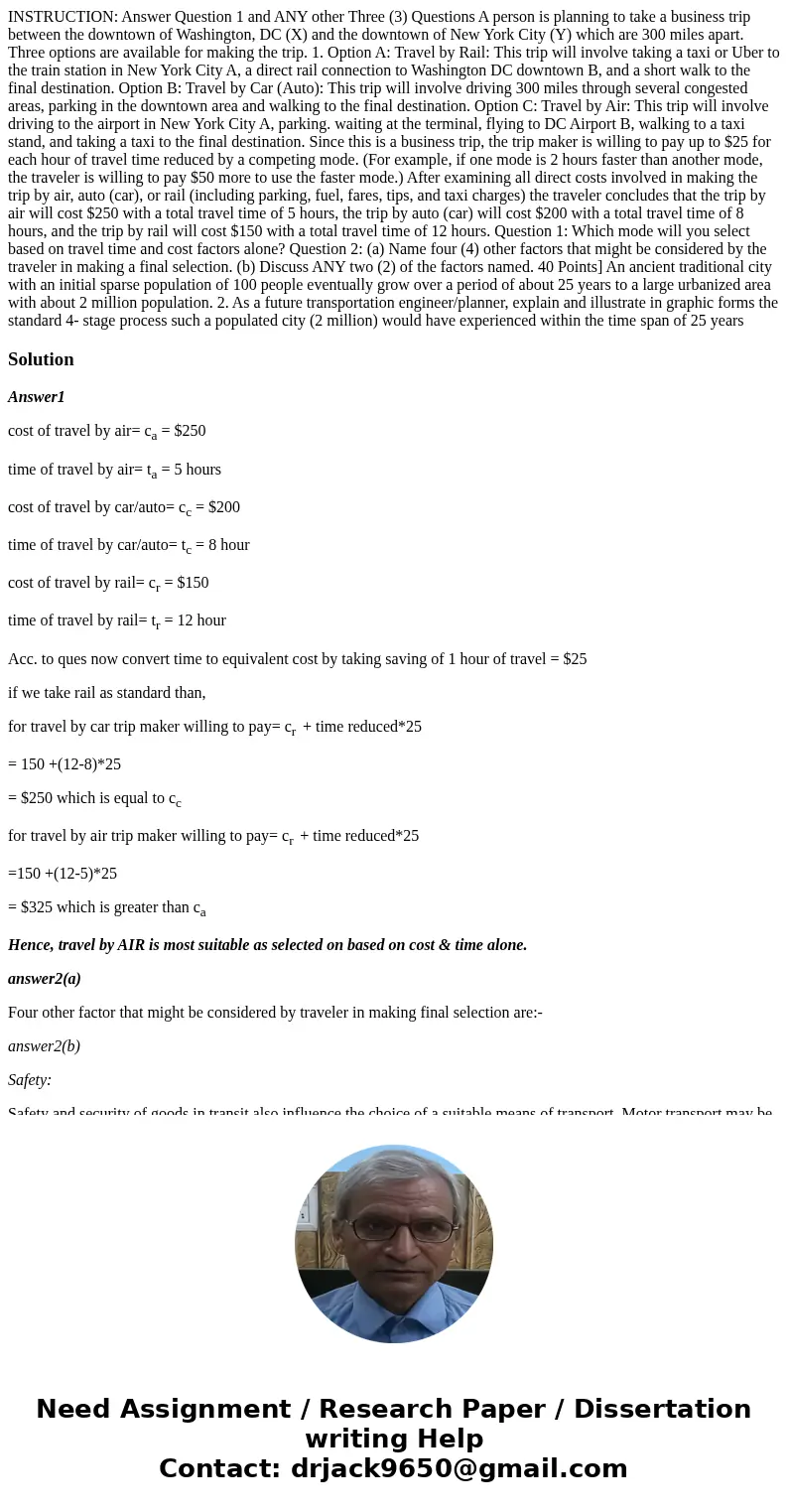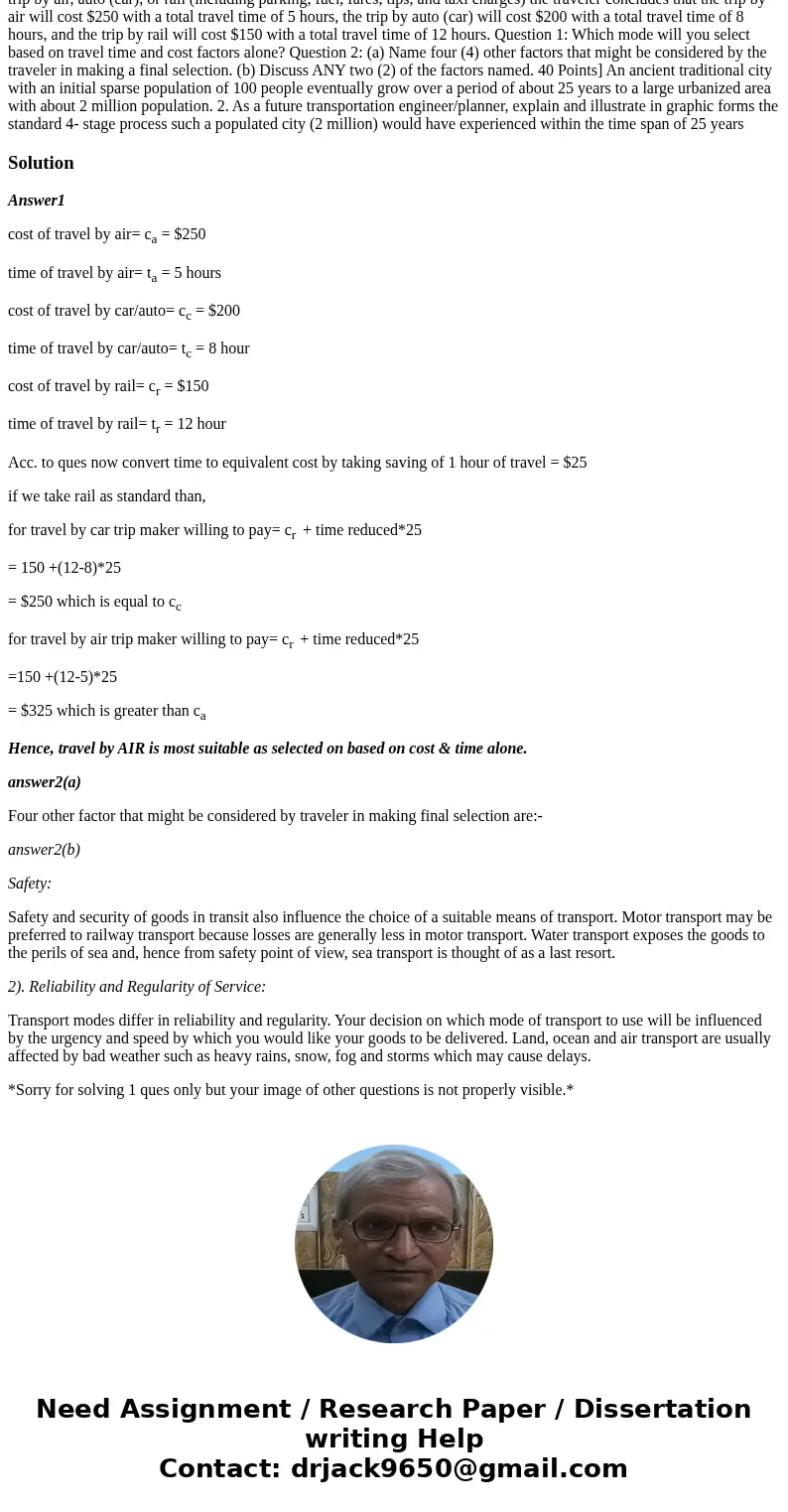INSTRUCTION: Answer Question 1 and ANY other Three (3) Questions A person is planning to take a business trip between the downtown of Washington, DC (X) and the downtown of New York City (Y) which are 300 miles apart. Three options are available for making the trip. 1. Option A: Travel by Rail: This trip will involve taking a taxi or Uber to the train station in New York City A, a direct rail connection to Washington DC downtown B, and a short walk to the final destination. Option B: Travel by Car (Auto): This trip will involve driving 300 miles through several congested areas, parking in the downtown area and walking to the final destination. Option C: Travel by Air: This trip will involve driving to the airport in New York City A, parking. waiting at the terminal, flying to DC Airport B, walking to a taxi stand, and taking a taxi to the final destination. Since this is a business trip, the trip maker is willing to pay up to $25 for each hour of travel time reduced by a competing mode. (For example, if one mode is 2 hours faster than another mode, the traveler is willing to pay $50 more to use the faster mode.) After examining all direct costs involved in making the trip by air, auto (car), or rail (including parking, fuel, fares, tips, and taxi charges) the traveler concludes that the trip by air will cost $250 with a total travel time of 5 hours, the trip by auto (car) will cost $200 with a total travel time of 8 hours, and the trip by rail will cost $150 with a total travel time of 12 hours. Question 1: Which mode will you select based on travel time and cost factors alone? Question 2: (a) Name four (4) other factors that might be considered by the traveler in making a final selection. (b) Discuss ANY two (2) of the factors named. 40 Points] An ancient traditional city with an initial sparse population of 100 people eventually grow over a period of about 25 years to a large urbanized area with about 2 million population. 2. As a future transportation engineer/planner, explain and illustrate in graphic forms the standard 4- stage process such a populated city (2 million) would have experienced within the time span of 25 years
Answer1
cost of travel by air= ca = $250
time of travel by air= ta = 5 hours
cost of travel by car/auto= cc = $200
time of travel by car/auto= tc = 8 hour
cost of travel by rail= cr = $150
time of travel by rail= tr = 12 hour
Acc. to ques now convert time to equivalent cost by taking saving of 1 hour of travel = $25
if we take rail as standard than,
for travel by car trip maker willing to pay= cr + time reduced*25
= 150 +(12-8)*25
= $250 which is equal to cc
for travel by air trip maker willing to pay= cr + time reduced*25
=150 +(12-5)*25
= $325 which is greater than ca
Hence, travel by AIR is most suitable as selected on based on cost & time alone.
answer2(a)
Four other factor that might be considered by traveler in making final selection are:-
answer2(b)
Safety:
Safety and security of goods in transit also influence the choice of a suitable means of transport. Motor transport may be preferred to railway transport because losses are generally less in motor transport. Water transport exposes the goods to the perils of sea and, hence from safety point of view, sea transport is thought of as a last resort.
2). Reliability and Regularity of Service:
Transport modes differ in reliability and regularity. Your decision on which mode of transport to use will be influenced by the urgency and speed by which you would like your goods to be delivered. Land, ocean and air transport are usually affected by bad weather such as heavy rains, snow, fog and storms which may cause delays.
*Sorry for solving 1 ques only but your image of other questions is not properly visible.*


 Homework Sourse
Homework Sourse